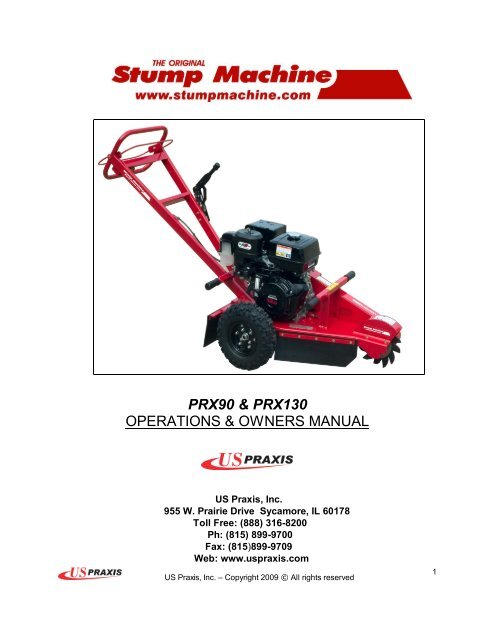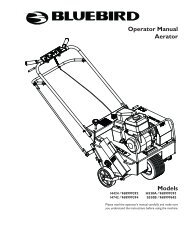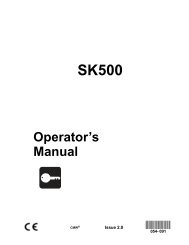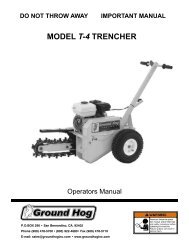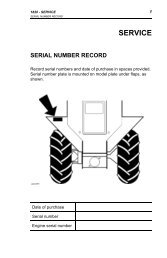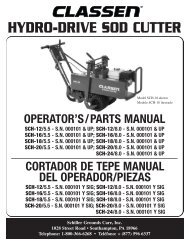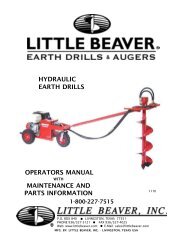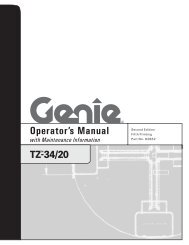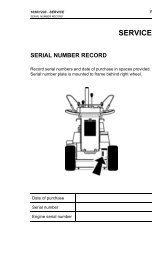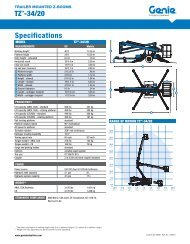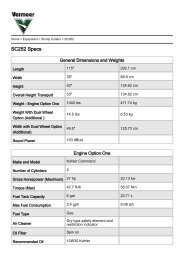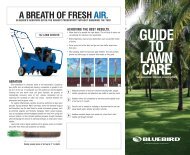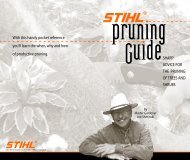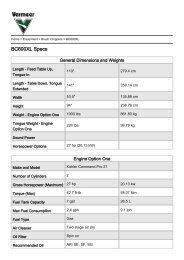prx90 & prx130 operations & owners manual - Ben's Rental and Sales
prx90 & prx130 operations & owners manual - Ben's Rental and Sales
prx90 & prx130 operations & owners manual - Ben's Rental and Sales
Create successful ePaper yourself
Turn your PDF publications into a flip-book with our unique Google optimized e-Paper software.
PRX90 & PRX130<br />
OPERATIONS & OWNERS MANUAL<br />
US Praxis, Inc.<br />
955 W. Prairie Drive Sycamore, IL 60178<br />
Toll Free: (888) 3168200<br />
Ph: (815) 8999700<br />
Fax: (815)8999709<br />
Web: www.uspraxis.com<br />
US Praxis, Inc. – Copyright 2009 © All rights reserved<br />
1
Introduction………………………………3<br />
Use & Service………..………………….3<br />
Safety Instructions……………………….4<br />
General Use………………...……………4<br />
Preparing to<br />
Use………..….…………….6<br />
Protective Equipment…..….………..…...8<br />
Operating……..………..….……………..9<br />
Movement/Transport.…..….………...…10<br />
Storage…..…………….….……………10<br />
Fuel System………..…………………...11<br />
Maintenance………...……………..…...12<br />
Controls………………………………….13<br />
Engine…………………….……………13<br />
Throttle…..……… ……………………13<br />
Starter……….……........………………13<br />
Starter H<strong>and</strong>le…….……………………14<br />
Fuel Valve.….…….……………………14<br />
Choke Control…….……………………14<br />
Air Filter….……….……………………14<br />
Spark Plug.……….…………….………15<br />
Muffler…..……….…………….………15<br />
Oil Dipstick……………………….……15<br />
Oil Drainage……….………….…......…16<br />
Fuel Tank………….………….…......…16<br />
Fueling…………….………….…......…16<br />
Centrifugal Clutch…………….…......…17<br />
Throttle…………….………….…......…17<br />
Brake…………..….……….….…......…17<br />
Operating The machine….……..………18<br />
Before you Start…………...………..…18<br />
Starting the Engine…..….….………….19<br />
Fuel Valve…………...……………...…19<br />
Choke Control………..….….………….19<br />
TABLE OF CONTENTS<br />
Praxis Stump Machines PRX90 & PRX130<br />
Throttle Grip H<strong>and</strong>le...………….…...…19<br />
Starter H<strong>and</strong>le………..……………...…20<br />
Grinding the Stump…..……………...…21<br />
Normal Shutdown…..…………..…...…22<br />
Maintenance……………………….……24<br />
Maintenance Schedule…………………24<br />
Cleaning the Filter…..…………………25<br />
Replacing the Filter……………………26<br />
Cleaning the Sludge Reservoir……..…27<br />
Idle Adjustment….……………………27<br />
Ignition System.….……………………28<br />
Cutting Blade…….……………………29<br />
Sharpening Cutting Blades……………30<br />
Brake Adjustment….…………………31<br />
Two Minute Rule…..…………………31<br />
Cleaning & Washing.…………………31<br />
Lubricating Bearings.…………………31<br />
Drive Belt…………..…………………32<br />
Trouble Shooting………………….……33<br />
Storage & Technical Data.……….……36<br />
Winter Storage…….…………………36<br />
Service…………….…………………36<br />
Specifications.…….…………………37<br />
Service Journal………………………38<br />
Parts List………………...……….……40<br />
H<strong>and</strong>le Assembly……………………40<br />
Chassis & Flap Assembly……………42<br />
Chassis & Engine Assembly…………44<br />
Brake & Wheel Assembly……..……46<br />
Brake & Shaft Assembly……………48<br />
Belt, Guard & Drive Assembly…..…50<br />
US Praxis, Inc. – Copyright 2009 © All rights reserved<br />
2
INTRODUCTION<br />
Congratulations:<br />
Thank you for purchasing a Praxis stump grinder. Through your confidence in us, you have chosen an<br />
exceptionally high quality product.<br />
This <strong>manual</strong> is a valuable document. It describes your new Praxis machine. Read the <strong>manual</strong> carefully<br />
before attempting to use the machine. Following the instructions (use, service, maintenance, etc.) can<br />
considerably increase the lifespan of your machine <strong>and</strong> even increase its resale value. Please contact your<br />
dealer for more information.<br />
If you sell your Praxis machine, make sure to give the operator’s <strong>manual</strong> to the new owner.<br />
Use:<br />
The Stump Machine is used to remove tree stumps. By moving the blade in sweeping movements laterally<br />
over the top <strong>and</strong> front of the stump, you can gradually grind it away. Read the chapter “Safety instructions”<br />
before you use the machine for the first time.<br />
Insure your machine:<br />
Contact your insurance company to check on insurance coverage for your new machine. You should have all<br />
inclusive insurance for liability, fire, damage <strong>and</strong> theft.<br />
Good service:<br />
Praxis products are sold all over the world <strong>and</strong> only in specialized retail trade with complete service. This<br />
ensures that you as a customer receive only the best support <strong>and</strong> service... Before the machine was delivered it<br />
underwent inspection <strong>and</strong> was adjusted by your dealer. When you need spare parts or support in service<br />
questions, guarantee issues, etc., please consult the following professional:<br />
The Operator’s Manual belongs to machine with<br />
serial number:<br />
Engine number:<br />
Serial number:<br />
The serial number can be found on the printed plate attached to the frame, next to the engine. The plate<br />
includes the following information:<br />
The machines type designation (MODEL).<br />
The machines serial number (S/N).<br />
Please state the type designation <strong>and</strong> serial number when ordering spare parts.<br />
The engines serial number is punched in the crankcase under the oil level guard.<br />
The engine type is specified on the crankcase to the right of the oil level guard but also appears on<br />
the decal on the starter.<br />
Please state these when ordering spare engine parts.<br />
US Praxis, Inc. – Copyright 2009 © All rights reserved<br />
3
SAFETY INSTRUCTIONS<br />
General use:<br />
The object of this <strong>manual</strong> is to help you use your Praxis machine safely <strong>and</strong> to give you<br />
information about how to maintain your machine. Please read the <strong>manual</strong> carefully before<br />
attempting to use the machine.<br />
Read this <strong>manual</strong> carefully <strong>and</strong> make sure you underst<strong>and</strong> it before using the machine or<br />
performing any maintenance. It is the responsibility of the machine owner to explain the contents<br />
to the user.<br />
If after reading the operator’s <strong>manual</strong> you are still unsure about the safety risks associated with<br />
use of the machine, you should not use the machine. Please contact your dealer or manufacturer<br />
for more information.<br />
These safety instructions only address the basics for safe use. It would be impossible in the safety<br />
instructions to describe all possible risk situations that could arise when using the machine. You<br />
can however, prevent accidents by always using common sense.<br />
To obtain extra copies of the operator’s <strong>manual</strong>; please contact your dealer or the manufacturer.<br />
IMPORTANT INFORMATION<br />
Do not use the machine until you have read the operator’s <strong>manual</strong> carefully <strong>and</strong><br />
underst<strong>and</strong> the instructions given. All maintenance work or adjustments not described in<br />
this <strong>manual</strong> must be performed by an authorized Praxis service provider.<br />
The stump grinder can be dangerous if used improperly or without due care <strong>and</strong> can lead<br />
to serious accidents, in the worst cases even fatal accidents. It is very important that you<br />
read this operator’s <strong>manual</strong> <strong>and</strong> underst<strong>and</strong> the instructions before you attempt to use the<br />
machine.<br />
Under no circumstances may the original design of the machine be modified without<br />
written approval from the manufacturer. Such modifications not only affect the<br />
performance <strong>and</strong> durability of the machine, but may even pose a safety risk for users <strong>and</strong><br />
those in the vicinity. Unauthorized modifications to the design of the machine may absolve<br />
the manufacturer from liability for any resulting personal injury or property damage.<br />
Modifying the machine without written approval from the manufacturer may void the<br />
guarantee.<br />
US Praxis, Inc. – Copyright 2009 © All rights reserved<br />
4
SAFETY INSTRUCTIONS<br />
Continued <br />
Follow all safety instructions. Failure could result in serious injury to yourself or others.<br />
Accident prevention regulations, other general safety regulations, occupational safety rules<br />
<strong>and</strong> traffic regulations must be followed without fail.<br />
All users must be trained in use of the machine before they begin operating it. The owner<br />
is responsible for training users.<br />
Engage an authorized Praxis service provider for all service <strong>and</strong> repairs not described in<br />
this <strong>manual</strong>.<br />
Praxis original spare parts are designed <strong>and</strong> specified to maintain high quality <strong>and</strong> correct<br />
fit for optimal durability <strong>and</strong> lifespan. From a safety point of view, you should only use<br />
Praxis replacement parts.<br />
Learn how to use the machine <strong>and</strong> its controls safely <strong>and</strong> learn to recognize the safety<br />
decals <strong>and</strong> their meaning.<br />
Only use the machine for removing tree stumps <strong>and</strong> exposed root systems. It is not<br />
intended for any other use.<br />
Check that the machine is in serviceable condition prior to use; see the chapter<br />
“Maintenance <strong>and</strong> Trouble Shooting”.<br />
Only use the machine in daylight or in other well lit conditions. Keep the machine a safe<br />
distance from holes or other irregularities in the ground. Pay attention to other possible<br />
risks.<br />
Only allow the machine to be used by adults who by adults who are familiar with its use.<br />
Never allow children or persons no trained in the use of the machine to use or service it.<br />
Local laws may regulate the age of the user.<br />
People <strong>and</strong> animals can distract you causing you to lose control of the machine. For this<br />
reason, you should always concentrate <strong>and</strong> focus on the task at h<strong>and</strong>.<br />
Never leave the machine unsupervised with the engine running.<br />
Make sure that other people are nearby when you are using the machine so that you can<br />
call for help should an emergency arise.<br />
The machine is tested <strong>and</strong> approved only with the equipment originally provided or<br />
recommended by the manufacturer.<br />
US Praxis, Inc. – Copyright 2009 © All rights reserved<br />
5
SAFETY INSTRUCTIONS<br />
Continued <br />
The engine can become very hot. To avoid being burned, you must turn off the engine <strong>and</strong><br />
wait until all parts have cooled before touching the engine.<br />
Overexposure to vibration may lead to circulatory or nerve damage, particularly in people<br />
who have impaired circulation. Contact your doctor if you experience symptoms that could<br />
have been caused by overexposure to vibration. Examples of common symptoms include<br />
numbness, pain, muscle weakness, change of skin color or an uncomfortable feeling of<br />
tingling. These symptoms appear most frequently in the fingers, h<strong>and</strong>s or wrists.<br />
IMPORTANT INFORMATION<br />
Never use a stump grinder that is damaged or incorrectly adjusted. Never use the stump<br />
grinder if any component is missing or if it is not properly assembled. Check that the<br />
cutting tools stop rotating when you reduce the throttle. If you find yourself in a situation<br />
where you are not sure what to do, always seek expert assistance. DO NOT try to attack<br />
any problem you are not qualified to resolve.<br />
US Praxis, Inc. – Copyright 2009 © All rights reserved<br />
6
Preparations:<br />
SAFETY INSTRUCTIONS<br />
Continued <br />
Make sure that you always have first aid equipment at h<strong>and</strong> when using the machine.<br />
Make sure nobody else is in the vicinity of the machine when you start the engine,<br />
engage the drive or run the machine.<br />
Make sure animals <strong>and</strong> people maintain a safe distance from the machine.<br />
Clear the area of objects such as stones, toys, steel wire, etc. that could become caught in<br />
moving machine parts <strong>and</strong> thrown out.<br />
Find <strong>and</strong> locate all fixed objects in the ground, such as sprinkler systems, poles, water<br />
valves, bases for washing lines, etc. Be certain to check for hidden electrical cables or<br />
similar in the surface of the lawn. Always run the machine around these objects. Never<br />
intentionally run the machine over foreign objects.<br />
Check the dead man’s grip <strong>and</strong> all guards are fitted <strong>and</strong> functioning. DO NOT use the<br />
machine if it is not working properly.<br />
Make sure no clothing, long hair or jewelry can catch in moving machine parts.<br />
Check that all safety decals are in place. See the chapter “Location of decals”.<br />
Use mouth protection, protective gloves with good grip <strong>and</strong> protective clothing which you<br />
can move unrestricted. Also use leg protection to protect your legs from sparks <strong>and</strong> the<br />
cutting tools.<br />
Never use the machine when barefoot. Always wear protective shoes or protective boots<br />
with antislip <strong>and</strong> preferably with steel toes.<br />
Use a helmet with a full face visor or a mesh visor <strong>and</strong> protective glasses. Wear approved<br />
earprotection when running the machine. Ask tour dealer about approved protective<br />
glasses, ear protection <strong>and</strong> recommended helmets.<br />
Always use approved protective clothing <strong>and</strong> approved protective equipment when using<br />
the machine. Protective clothing <strong>and</strong> protective equipment cannot eliminate the risk of<br />
accidents, but wearing proper clothing <strong>and</strong> the correct equipment will reduce the degree of<br />
injury should an accident occur. Ask your dealer about approved protective clothing <strong>and</strong><br />
approved protective equipment recommended by Praxis.<br />
US Praxis, Inc. – Copyright 2009 © All rights reserved<br />
7
SAFETY INSTRUCTIONS<br />
Continued <br />
Protective equipment:<br />
Consult your dealer when selecting protective equipment. Our dealers have a broad assortment of<br />
equipment for professionals such as forestry workers <strong>and</strong> knowledge about occupational<br />
environment requirements <strong>and</strong> protective levels.<br />
Before using the stump grinder, you may in many cases need to cut back to object with a power<br />
saw. Hence, it is appropriate to use personal protective equipment that fulfils requirements for<br />
working with both stump grinders <strong>and</strong> power saws.<br />
The main difference is that you should wear protective glasses when operating the stump grinder<br />
while the wire mesh visor gives sufficient protection when using a power saw. Thus when using<br />
the stump grinder, we recommend using both a wire mesh or visor to protect your face <strong>and</strong><br />
protective glasses. Alternatively, you can use a Plexiglas face guard, but it scratches more easily<br />
<strong>and</strong> is more susceptible to soiling <strong>and</strong> fogging.<br />
US Praxis, Inc. – Copyright 2009 © All rights reserved<br />
8
SAFETY INSTRUCTIONS<br />
Continued <br />
Operating:<br />
DO NOT use the machine on grades of more than 10<br />
degrees.<br />
DO NOT use the machine if you are tired, if you have<br />
consumed alcohol, or if you are taking other drugs or<br />
medication that can affect your vision, judgment or<br />
coordination.<br />
Never use the machine indoors or in spaces lacking<br />
proper ventilation.<br />
Make sure you have a proper foothold when using the machine, particularly when backing.<br />
Walk, don’t run. Never work on wet grass. Poor traction may cause you to slip.<br />
Keep your h<strong>and</strong>s <strong>and</strong> feet away from moving parts.<br />
Keep your h<strong>and</strong>s <strong>and</strong> feet away from the work tools.<br />
DO NOT use your feet or other parts of your body parts of your body to gain greater<br />
bearing pressure against the stump.<br />
Smoking, open flames or sparks in the vicinity of the machine are strictly<br />
forbidden. Gasoline is extremely flammable <strong>and</strong> carelessness in h<strong>and</strong>ling can result in<br />
personal injury or fire.<br />
Never use a machine with a deflective muffler.<br />
In very warm <strong>and</strong> dry climates, stump grinder<br />
operation poses a risk of forest fires.<br />
Stop <strong>and</strong> inspect the equipment if you run over or into<br />
anything. If necessary, make repairs before beginning<br />
again.<br />
Whatever happens, you should always park the<br />
machine on even ground, disengage the drive, activate<br />
the parking, turn off the engine <strong>and</strong> wait until all moving parts have stopped before leaving<br />
the operating position behind the machine.<br />
Serious accidents can occur if you fail to be on guard for children in the vicinity of the<br />
machine. Never assume that children will stay put where you last saw them.<br />
US Praxis, Inc. – Copyright 2009 © All rights reserved<br />
9
Keep children away from the machine.<br />
SAFETY INSTRUCTIONS<br />
Continued <br />
Keep children away from the work area <strong>and</strong> under close<br />
supervision by another adult.<br />
Never allow children to operate the machine.<br />
Be particularly careful near corners, bushes trees or other<br />
objects that block your view.<br />
Movement/Transport:<br />
To turn <strong>and</strong> steer the machine, press down on the h<strong>and</strong>le <strong>and</strong> turn on the back wheels.<br />
Turn off the engine <strong>and</strong> allow it to cool at least 2 minutes before transport.<br />
Be careful <strong>and</strong> use safe lifting <strong>and</strong> moving techniques when loading/unloading the<br />
machine.<br />
We recommend having two people to lift the machine.<br />
Activate the parking brake during transport.<br />
Fasten the machine properly in place with approved fasteners, such as tension belts,<br />
chains or rope. Always check that you are in compliance with applicable traffic<br />
regulations before transporting the machine.<br />
Storage:<br />
Allow the engine to cool before storing the machine. Never store the machine near an<br />
open flame.<br />
Store the machine with the fuel valve closed.<br />
Store the machine <strong>and</strong> fuel in such a way that there is no risk that leaking fuel or fumes<br />
can come in contact with flames or sparks from electrical machines, electric engines,<br />
relays, switches, boilers or similar.<br />
Store the machine in a locked space away from children <strong>and</strong> adults untrained in use of<br />
the machine.<br />
US Praxis, Inc. – Copyright 2009 © All rights reserved<br />
10
Never store or operate the machine near an open flame.<br />
SAFETY INSTRUCTIONS<br />
Continued <br />
Gasoline <strong>and</strong> gasoline fumes are poisonous <strong>and</strong> extremely flammable. Be especially<br />
careful when h<strong>and</strong>ling gasoline, as carelessness can result in personal injury or fire.<br />
Fuel System:<br />
Only store fuel in containers approved for that purpose.<br />
Never remove the fuel cap <strong>and</strong> fill the fuel tank when the engine is running.<br />
Always stop the engine when refueling.<br />
Do not smoke when filling the gasoline tank <strong>and</strong> do not pour gasoline in the vicinity of<br />
sparks or open flame.<br />
Never fill the fuel tank indoors.<br />
Before starting the machine after refueling, it should be moved at least 10 feet (3 M)<br />
from the location where it was filled.<br />
Turn off the fuel supply for storage or transport.<br />
If leaks arise in the fuel system, the engine must not<br />
be started until the problem has been resolved.<br />
Check the fuel level before each use <strong>and</strong> leave space<br />
for the fuel to exp<strong>and</strong>, because the heat from the<br />
engine <strong>and</strong> the sun can otherwise cause the fuel to<br />
exp<strong>and</strong> <strong>and</strong> overflow.<br />
Avoid overfilling. If you spill gasoline on the<br />
machine, wipe up the spill <strong>and</strong> wait until it has<br />
evaporated before starting the engine. If you spill<br />
gasoline on your clothing, change your clothing.<br />
Close the fuel valve.<br />
US Praxis, Inc. – Copyright 2009 © All rights reserved<br />
11
Maintenance:<br />
SAFETY INSTRUCTIONS<br />
Continued <br />
Never make adjustments with the engine running.<br />
Disengage the drive units, shut off the engine <strong>and</strong><br />
wait until all moving parts come to a complete<br />
stop before making adjustments, performing<br />
maintenance or cleaning the machine.<br />
Disconnect the spark plug cable before beginning<br />
repair work.<br />
Keep all components in serviceable condition <strong>and</strong><br />
make sure all nuts, bolts, etc. are tight.<br />
Replace worn or damaged decals.<br />
Be careful when checking work tools. Use gloves when performing maintenance work.<br />
Never allow persons not trained in the use of the machine to perform service on it.<br />
Always park the machine on even ground before performing maintenance or making<br />
adjustments.<br />
Do not disassemble the engine. This can invalidate your engine warranty. Contact your<br />
dealer if you have any questions regarding service or guarantee matters. Follow all<br />
maintenance instructions.<br />
Do not change the setting of governors <strong>and</strong> avoid running the engine with overly high<br />
RPM. If you run the engine too fast, you risk damaging the machine components.<br />
Do not modify safety equipment. Check regularly to be sure it works properly. The<br />
machine must not be run with defective of disassembled safety equipment.<br />
The muffler is designed to maintain sound levels at an approved level <strong>and</strong> keep direct<br />
exhaust away from the user. Exhaust gases from the engine are extremely hot <strong>and</strong> may<br />
contain sparks that can cause fires or burn the user.<br />
Never use a machine with a defective muffler.<br />
Disconnect the spark plug cable.<br />
Reduce the risk of fire by removing grass, leaves <strong>and</strong> other debris that may have caught<br />
in the machine.<br />
Wait until all moving parts are completely still before performing maintenance on the machine.<br />
Turn off the engine <strong>and</strong> remove the spark plug cable.<br />
US Praxis, Inc. – Copyright 2009 © All rights reserved<br />
12
Engine:<br />
Exterior engine components <strong>and</strong> controls.<br />
1. Throttle<br />
2. Starter<br />
3. Starter h<strong>and</strong>le<br />
4. Fuel valve<br />
5. Choke control<br />
6. Air filter<br />
7. Spark Plug<br />
8. Muffler<br />
9. Oil dipstick<br />
10. Oil drainage<br />
11. Oil level guard<br />
13. Fuel tank<br />
14. Fuel filler cap<br />
Throttle:<br />
CONTROLS<br />
The lever on the engine is normally not used. It is<br />
connected to the throttle on the h<strong>and</strong>le. If the cable<br />
should bind or break, you can reduce the throttle with<br />
the lever on the engine as an emergency measure to<br />
slow the engine speed to an idle <strong>and</strong> stop the cutting<br />
wheel.<br />
Starter:<br />
The starter is of the magnapull type with spring return.<br />
To replace the return spring or starter cord, contact<br />
an authorized service workshop.<br />
US Praxis, Inc. – Copyright 2009 © All rights reserved<br />
13
Starter h<strong>and</strong>le:<br />
CONTROLS<br />
Continued <br />
Misuse of the starter h<strong>and</strong>le can damage the starter. Do not twist the starter cord around your<br />
h<strong>and</strong>.<br />
Pull out the h<strong>and</strong>le slowly until the gears mesh. Do<br />
not pull out the starter cord completely <strong>and</strong> do not let<br />
go of the starter h<strong>and</strong>le when extended.<br />
Fuel valve:<br />
The fuel valve opens <strong>and</strong> closes the connection<br />
between the tank <strong>and</strong> the carburetor.<br />
The illustration shows the tank valve closed; to open,<br />
turn the lever completely to the right. There is no<br />
middle position.<br />
Turn off the valve when the machine is not in use to<br />
avoid flooding the carburetor.<br />
The fuel valve is combined with a sludge reservoir.<br />
Choke control:<br />
The choke control opens <strong>and</strong> closes the choke valve in<br />
the carburetor. This is only used to start a cold<br />
engine.<br />
The image shows the choke valve open; to close,<br />
move the lever to the left. The midway positions can<br />
be used. When the engine starts, the lever can be<br />
moved gradually to the right as long as it continues to<br />
run smoothly. Forgetting the choke is evident as the<br />
engine runs roughly <strong>and</strong> produces black smoke.<br />
This also results in increased fuel consumption.<br />
Air filter:<br />
The engine air filter consists of a cyclone filter <strong>and</strong> a fine filter.<br />
Air is drawn in through the screen (3) on the cyclone filter <strong>and</strong> coarser pollutants collect in the<br />
container (4).<br />
US Praxis, Inc. – Copyright 2009 © All rights reserved<br />
14
Air filter (Continued):<br />
CONTROLS<br />
Continued <br />
The fine filter, which consists of a cyclone filter <strong>and</strong> a fine filter.<br />
Air is drawn in through the screen (3) on the cyclone filter <strong>and</strong> coarser pollutants collect in the<br />
container (4).<br />
The fine filter, which consists of a foam rubber prefilter <strong>and</strong> a paper filter cartridge, is located<br />
under the cowling(2). The cowling <strong>and</strong> the cyclone filter can be removed by removing the wing<br />
nut (1).<br />
See the chapter “Maintenance/Cleaning the cyclone filter <strong>and</strong> Replacing the air filter” for cleaning<br />
instructions.<br />
Running the machine with a dirty air filter will cause the engine to run on partial choke <strong>and</strong> show<br />
the same symptoms as a forgotten choke described above. It can also be difficult to start.<br />
Spark Plug:<br />
The engine spark plug is hidden under the ignition cable<br />
shoe. When performing service, it is important that the<br />
engine cannot start accidentally. For this reason, always<br />
remove the ignition cable shoe from the spark plug. To<br />
avoid pulling the cable, the cable shoe is equipped with a<br />
special h<strong>and</strong>le; see the illustration.<br />
Type of spark plug, see “Technical data”.<br />
Service instructions see“Maintenance/Electrical system”.<br />
Muffler:<br />
The engine muffler is equipped with a heat protective cowling. Nonetheless, it still becomes hot<br />
when the engine is running. Avoid touching the muffler when it is warm. Risk for burns.<br />
Oil dipstick:<br />
The dipstick for the crankcase oil reservoir is<br />
located on the front of the engine. Refill the engine oil in<br />
the hole where the dipstick fits.<br />
When checking the oil level, the dipstick should not be<br />
screwed in. The machine should be parked on even<br />
ground with the engine stopped. Never run the engine<br />
without the dipstick in place. The engine has an electronic<br />
oil level guard. It stops <strong>and</strong> cannot be started if the level<br />
becomes too low. Yet you should not rely<br />
entirely on the level guard; rather you should check the oil using the dipstick.<br />
For normal use, we recommend SAE 10W30 weight<br />
engine oil service SFSG; see also the chapter “Lubrication/Engine oil”.<br />
US Praxis, Inc. – Copyright 2009 © All rights reserved<br />
15
Oil drainage:<br />
CONTROLS<br />
Continued <br />
The drainage screw (5) for the crankcase oil reservoir is<br />
located on the back of the engine.<br />
IMPORTANT INFORMATION<br />
Used engine oil is a health hazard <strong>and</strong> legislation<br />
prohibits disposal on the ground or in nature; it<br />
should always be disposed of at a workshop or<br />
appropriate disposal location. Avoid skin contact;<br />
wash with soap <strong>and</strong> water in case of spills.<br />
Fuel tank:<br />
Underneath the tank, there is a fuel filter combined with a fuel valve. The tank volume is 1.72<br />
Gal. (6.5 liters)<br />
Fueling:<br />
Read the safety instructions before fueling.<br />
Keep the fuel <strong>and</strong> fuel tank clean. Avoid<br />
filling the machine with dirty fuel. Make sure<br />
the fuel cap is properly tightened <strong>and</strong> the<br />
gasket is not damaged, particularly before<br />
washing the machine.<br />
Use unleaded gasoline with minimum 86<br />
octane rating. Never use gasoline mixed with<br />
twocycle oil. For ethanol <strong>and</strong> methanol fuel,<br />
the following applies:<br />
Maximum allowable ethanol 10% (volume).<br />
Maximum allowable methanol 5% (volume).<br />
Maximum allowable MTBE (Methyl Tertiary Butyl Ether) 15% (volume).<br />
If the engine “bolts” at normal load it can be damaged. Change the fuel. If this does not help,<br />
contact an authorized service workshop.<br />
Do not fill the tank completely; leave space for the fuel to exp<strong>and</strong> as it warms up.<br />
Gasoline Is highly flammable. Observe caution <strong>and</strong> fill the tank outdoors. (See the safety<br />
instructions.<br />
US Praxis, Inc. – Copyright 2009 © All rights reserved<br />
16
CONTROLS<br />
Continued <br />
Centrifugal clutch:<br />
The engine is equipped with a centrifugal clutch that<br />
is connected to the crankshaft. When the engine<br />
speed increases, the drive for cutting wheel engages<br />
automatically. The centrifugal clutch is<br />
maintenancefree; it is not possible for the user to<br />
make adjustments.<br />
Throttle:<br />
The lever controls engine speed.<br />
With the lever down, the engine runs at idle <strong>and</strong> functions as start position.<br />
When the engine speed increases, the centrifugal clutch drive automatically engages the cutting<br />
wheel.<br />
Brake:<br />
The lever activates a disk brake on the left wheel when it is pulled backwards. The brake should<br />
always be activated when operating the grinder, when it is parked <strong>and</strong> when it is being<br />
transported.<br />
NEVER operate a machine with a defective brake.<br />
US Praxis, Inc. – Copyright 2009 © All rights reserved<br />
17
OPERATING THE MACHINE<br />
Before you start:<br />
Dig away the earth <strong>and</strong> remove any stones near the<br />
tree stump that may interfere with your work.<br />
Check that the ground is free of foreign objects,<br />
such as electrical cables, barbed wire, etc.<br />
Cut or trim the stump as necessary using a power<br />
saw.<br />
Review all the machine’s safety decals.<br />
Use a hardhat, ear <strong>and</strong> eye protection. A<br />
mesh visor alone does not provide<br />
sufficient eye protection; supplement with<br />
protective glasses.<br />
Make sure that you are familiar with safety<br />
regulations <strong>and</strong> shutdown procedures<br />
described previously in the operator’s<br />
<strong>manual</strong>.<br />
Make sure that all guards are in place <strong>and</strong><br />
in good condition.<br />
Make sure that the blades <strong>and</strong> cutters are in<br />
place <strong>and</strong> in good condition.<br />
Make sure that the work area <strong>and</strong> cutter in<br />
particular <strong>and</strong> free from metallic objects<br />
such as wire, nails, etc. that could be<br />
thrown out <strong>and</strong> injure persons in the<br />
vicinity <strong>and</strong> damage the equipment.<br />
Make sure that everyone, including<br />
children <strong>and</strong> animals, maintain a distance of at<br />
least 50 feet (15 m) from the machine.<br />
Debris can be thrown out <strong>and</strong> injure people<br />
<strong>and</strong> animals.<br />
US Praxis, Inc. – Copyright 2009 © All rights reserved<br />
18
OPERATING THE MACHINE<br />
Continued<br />
Starting the engine:<br />
Check that all daily maintenance as described in the maintenance schedule has been performed.<br />
Check that there is sufficient fuel in the tank.<br />
Fuel valve:<br />
Open the fuel valve. Place the lever all<br />
the way to the right.<br />
Choke control:<br />
When starting the engine warm, the lever<br />
should be in the right position; see the<br />
illustration.<br />
When starting the engine cold or<br />
partially warm, place the lever<br />
completely or partly to the left.<br />
Move the lever back to the right once<br />
the engine starts. When the engine is<br />
cold, it may be best to move the lever<br />
back in several stages. Find the position<br />
where the engine runs smoothly.<br />
Throttle<br />
Set the throttle on the h<strong>and</strong>le to the SLOW (START)/DISENGAGE position.<br />
US Praxis, Inc. – Copyright 2009 © All rights reserved<br />
19
Safety presence grip bar<br />
Hold in the safety presence grip bar against the<br />
h<strong>and</strong>le.<br />
OPERATING THE MACHINE<br />
Continued<br />
Starter h<strong>and</strong>le:<br />
The dead man’s grip must be pressed in when starting<br />
the engine.<br />
Misuse of the starter h<strong>and</strong>le can damage the starter.<br />
DO NOT twist the starter cord around your h<strong>and</strong>,<br />
Pull out the h<strong>and</strong>le slowly until the gears mesh. Then<br />
give a sharp pull on the starter h<strong>and</strong>le.<br />
DO NOT pull out the starter cord completely <strong>and</strong><br />
DO NOT let go of the starter h<strong>and</strong>le when extended.<br />
Throttle<br />
Keep the throttle at idle. When the throttle is<br />
increased, the cutting wheel will begin rotating.<br />
US Praxis, Inc. – Copyright 2009 © All rights reserved<br />
20
OPERATING THE MACHINE<br />
Continued<br />
1. Place stump machine into position with cutting<br />
blade near the fronttop edge of stump.<br />
2. Set brake to lock position.<br />
3. Set throttle to (START) DISENGAGE position.<br />
4. Start engine.<br />
5. Allow engine to warm up at idle for two minutes.<br />
6. Move throttle up to the ENGAGE position (this<br />
will engage the cutting blade rotation).<br />
7. Swing the cutting blade to one side, then lower it<br />
approximately 1/2" to 1" into the fronttop<br />
corner of the stump. Swing the cutting blade<br />
back <strong>and</strong> forth, lowering the cutting blade<br />
approximately 1/2" to 1" before each sweep, until<br />
you have removed the front portion of the stump<br />
to ground level.<br />
8. Raise cutting blade until center of cutting blade is<br />
just above top of stump.<br />
9. With the cutting blade off to one side, advance<br />
the machine horizontally by releasing <strong>and</strong><br />
resetting the brake. Advance the machine<br />
forward to engage the cutting blade into the<br />
stump so that when swept across the stump it will<br />
remove 1/2" to 1" of stump with each sweep.<br />
10. Sweep the cutting blade across the stump, cutting away 1/2" to 1" of stump.<br />
11. Advance cutting blade 1/2" to 1", <strong>and</strong> sweep<br />
across stump in opposite direction.<br />
12. Continue sweeping cutting blade left <strong>and</strong> right<br />
across stump, advancing it before each sweep,<br />
cutting 1/2" to 1" depth of stump with each<br />
sweep.<br />
13. Continue cutting until top level of stump is all<br />
removed, making sure not to cut stump deeper than ground level during this first stage.<br />
OPERATING THE MACHINE<br />
US Praxis, Inc. – Copyright 2009 © All rights reserved<br />
21
Continued<br />
14. Turn throttle to the (START)DISENGAGE position, wait ten seconds for blade to stop<br />
rotating then release brake <strong>and</strong> retract<br />
machine from stump.<br />
15. Pull machine away from stump, <strong>and</strong> rake<br />
chips away from stump.<br />
16. Place stump machine into position with<br />
cutting blade near the fronttop edge of<br />
the stump.<br />
17. Set brake to lock position.<br />
18. Move throttle up to the ENGAGE position.<br />
19. Complete cutting stump by repeating step 12 again <strong>and</strong> again until entire stump is cut to<br />
desired depth.<br />
20. Stop the machine.<br />
Normal shutdown<br />
Throttle<br />
Set the throttle to SLOW/DISENGAGE.<br />
If the engine has been running full out, let it run easily<br />
for about 30 seconds to one minute at low speed.<br />
DO NOT let front of unit touch ground until you are<br />
sure cutting wheel has stopped turning.<br />
A rotating cutting blade is very DANGEROUS!<br />
Stay at the operating position <strong>and</strong> be sure that the blade comes to a complete stop before doing<br />
anything else.<br />
US Praxis, Inc. – Copyright 2009 © All rights reserved<br />
22
Brake<br />
Activate the brake by pulling the lever.<br />
Fuel valve<br />
OPERATING THE MACHINE<br />
Continued<br />
Close the fuel valve. Turn the lever all the way to<br />
the left (see illustration).<br />
Release the safety presence bar.<br />
Wait until the blade stops.<br />
Make sure that the blade is resting against the<br />
ground <strong>and</strong> has stopped completely before doing<br />
anything.<br />
US Praxis, Inc. – Copyright 2009 © All rights reserved<br />
23
MAINTENANCE<br />
Maintenance schedule<br />
The following is a list of maintenance procedures that MUST be performed on the machine. For<br />
those points not described in this <strong>manual</strong>, call your dealer or the manufacturer directly.<br />
1) First change after 20 hours. 2) In dusty conditions maintenance is required at shorter intervals.<br />
3) Before each use. 4) Performed by authorized service workshop. 5) Performed every second year.<br />
6) Grease every 4 hours.<br />
No service <strong>operations</strong> may be performed on the engine or unit unless:<br />
The engine is stopped.<br />
The ignition cable has been removed from the spark plug.<br />
The machine is securely parked where it will not tip or begin rolling.<br />
US Praxis, Inc. – Copyright 2009 © All rights reserved<br />
24
MAINTENANCE<br />
Continued<br />
Cleaning the cyclone filter<br />
The cyclone filter collects the largest contaminant<br />
particles, which collect in the container. When<br />
you can see a layer of dirt at the bottom of the<br />
container, the cyclone housing (4), air channels<br />
<strong>and</strong> air intake screen (3) must be cleaned.<br />
Remove the three screws holding the cyclone<br />
housing. Remove the housing with the air intake<br />
screen <strong>and</strong> remove the air channels.<br />
The air channels may remain in the upper portion<br />
or follow along with the housing when removed.<br />
Clean the components. Use water, detergent <strong>and</strong><br />
a washingup brush. Dry carefully.<br />
Refit the components. Place the air channels in<br />
the cyclone housing. Insert cyclone housing into<br />
position <strong>and</strong> make sure it fits in the upper<br />
portion. DO NOT use force; rater coax it into<br />
place before fitting the screws.<br />
IMPORTANT INFORMATION<br />
Exercise care when reassembling to<br />
avoid damaging anything.<br />
Make sure when mounting that the air<br />
intake screen fits exactly in its guide in<br />
the upper portion.<br />
Make sure the air channel ends up in<br />
the proper position.<br />
MAINTENANCE<br />
US Praxis, Inc. – Copyright 2009 © All rights reserved<br />
25
Replacing the air filter<br />
Continued<br />
If the engine seems weak, produces black smoke or<br />
runs unevenly, the air filter may be clogged. For this<br />
reason, it is important to clean <strong>and</strong> replace the air<br />
filter regularly (see the maintenance schedule for the<br />
proper service interval).<br />
Allow the exhaust system to cool before<br />
performing service. Risk for burns.<br />
Cleaning/replacement of the air filter is carried out as<br />
follows:<br />
1. Undo the wing nut (1) <strong>and</strong> lift off the cyclone<br />
filter with the air filter cowling (2).<br />
2. Remove the foam rubber prefilter <strong>and</strong> clean<br />
using a mild detergent.<br />
Squeeze it dry with a clean cloth.<br />
Soak it with new engine oil. Wind the filter in<br />
an absorbent cloth <strong>and</strong> squeeze out excess oil.<br />
3. Remove the wing nut in the air filter <strong>and</strong> remove<br />
the paper filter. Tap the paper filter against a<br />
fixed surface to remove dust. If the paper filter is<br />
still dirty or damaged, it MUST be replaced.<br />
IMPORTANT INFORMATION<br />
DO NOT use compressed air over 2 bar/30 PSI<br />
to clean the paper filter.<br />
DO NOT wash the paper filter.<br />
DO NOT oil the paper filter.<br />
4. Refit the air filter as follows:<br />
Mount the paper filter in the air filter housing<br />
<strong>and</strong> tighten the wing nut.<br />
5. Refit the prefilter on the paper filter.<br />
6. Refit the cyclone filter with the air filter cowling.<br />
MAINTENANCE<br />
US Praxis, Inc. – Copyright 2009 © All rights reserved<br />
26
Cleaning the sludge reservoir:<br />
1. Close the fuel valve.<br />
2. Unscrew the sludge reservoir (2). Make<br />
sure not to misplace the oring (1).<br />
3. Clean the reservoir <strong>and</strong> the owing using a<br />
cleaning solvent <strong>and</strong> dry carefully.<br />
4. Put the oring in place in its track <strong>and</strong><br />
replace the sludge reservoir (2). Make sure<br />
not to misplace the oring (1).<br />
5. Turn the fuel valve to ON <strong>and</strong> check for<br />
leaks. If it leaks, replace the oring.<br />
Idle adjustment<br />
Risk for carbon monoxide poisoning. Perform<br />
the adjustment outdoors.<br />
1. Start the engine <strong>and</strong> run it until it reaches<br />
normal working temperature.<br />
2. Adjust the throttle to idle position or so that<br />
the engine runs at the lowest possible speed.<br />
3. Turn the idle screw (1) so that the engine<br />
idles at 12501550 RPM.<br />
4. Increase the idle speed with the throttle <strong>and</strong><br />
move it right back to idle position. Check<br />
engine speed again.<br />
Continued<br />
MAINTENANCE<br />
US Praxis, Inc. – Copyright 2009 © All rights reserved<br />
27
Ignition system:<br />
Continued<br />
The engine is equipped with an electronic ignition<br />
system. Only the spark plug requires maintenance.<br />
For recommended spark plug, see “Technical data”.<br />
IMPORTANT INFORMATION<br />
Fitting the wrong spark plug type can damage the<br />
engine.<br />
1. Remove the ignition cable shoe <strong>and</strong> clean around<br />
the spark plug.<br />
2. Remove the spark plug with a 3/16" (21mm)<br />
spark plug socket wrench.<br />
3. Check the spark plug. Replace the spark plug if<br />
the electrodes are burned or if the insulation is<br />
cracked or damaged. Clean the spark plug with a<br />
steel brush if it is to be reused.<br />
4. Measure the electrode gap with a gapping tool.<br />
The gap should be 0.70.8 mm/0.0280.031".<br />
Adjust as necessary by bending the side<br />
electrode.<br />
5. Reinsert the spark plug, turning by h<strong>and</strong> to avoid<br />
damaging the threads.<br />
IMPORTANT INFORMATION<br />
Inadequately tightened spark plugs can caus<br />
overheating <strong>and</strong> damage the engine. Tightening the<br />
spark plug too much can damage the threads in the<br />
cylinder head.<br />
6. After the spark plug is seated, tighten it using a spark plug wrench so that the washer is<br />
compressed. A used spark plug should be turned 1/81/4 of a turn from the seated position. A<br />
new spark plug should be turned ½ a turn from the seated position.<br />
7. Replace the ignition cable shoe.<br />
MAINTENANCE<br />
US Praxis, Inc. – Copyright 2009 © All rights reserved<br />
28
Continued<br />
Cutting blade:<br />
Among the most critical elements of the Stump Machine is the cutting blade. It is also the most<br />
subject to damage <strong>and</strong> wear. In the course of grinding stumps it not only makes contact with the<br />
wood, but also encounters numerous assortments of abrasives <strong>and</strong> objects in the stump’s<br />
environment, such as dirt, stones, <strong>and</strong> occasionally a large rock or buried scrap.<br />
The loss of <strong>and</strong> wear of cutting teeth can significantly impair the efficiency <strong>and</strong> performance of the<br />
Stump Machine. Therefore, it is important to make frequent observations of the condition of all<br />
of the cutting teeth <strong>and</strong> replace or sharpen any damaged or worn blade sections.<br />
NOTICE<br />
Read all the following instructions before beginning to change cutting blade sections.<br />
1. Clean all dirt from the cutting blade <strong>and</strong> mounting flanges.<br />
2. Remove all bolts holding cutting blade, (Be<br />
careful not to let a section drop when they<br />
become loose).<br />
3. Check each section for cracks. Replace blade<br />
section if it is cracked.<br />
4. When replacing cutting blade sections, make<br />
sure blade section is placed in alignment with<br />
blade rotation.<br />
5. Refer to page of this Manual for proper blade<br />
attachment.<br />
Installing new blades:<br />
Insert blade section between the blade mounting<br />
flanges.<br />
Slide bolt through one side of flange, <strong>and</strong> through<br />
flange on other side. Attach lock washer <strong>and</strong> nut,<br />
tighten securely. (Make sure tow bolts are<br />
tightened for each blade section).<br />
MAINTENANCE<br />
US Praxis, Inc. – Copyright 2009 © All rights reserved<br />
29
Continued<br />
Sharpening Cutting Blade Sections:<br />
Do not allow the cutting blade to wear too much before sharpening. The cutting blade sections<br />
must be removed from the machine before sharpening.<br />
NOTICE<br />
Sharpening carbide cutting teeth requires a special process.<br />
US Praxis, Inc.<br />
OFFERS A COMPLETE LINE OF SHARPENING ACCESSORIES AND<br />
SHARPENING SERVICES<br />
Toll Free: 8883168200<br />
MAINTENANCE<br />
US Praxis, Inc. – Copyright 2009 © All rights reserved<br />
30
Brake Adjustment<br />
For fine adjustment, loosen set screw on side of<br />
brake lever knob. Adjust clockwise to tighten<br />
brake; adjust counter clockwise to loosen brake.<br />
(Wheel should lock completely, tighten set<br />
screw). For coarse adjustment, turn adjusting<br />
nuts on brake cable fitting at brake cable mount.<br />
Continued<br />
Two minute rule<br />
The machine may be tipped backward or on its<br />
side to facilitate access for cleaning or service,<br />
but no longer than 2 minutes.<br />
If the machine is held in this position for too<br />
long, the engine can be damaged by gasoline<br />
draining into the crankcase. Should this happen,<br />
perform an extra oil change on the engine over a<br />
few revolutions with the starter h<strong>and</strong>le before starting the engine again.<br />
Cleaning <strong>and</strong> washing<br />
Regular cleaning <strong>and</strong> washing will increase the machine’s life span. Make it a habit to clean the<br />
machine directly after use, before the dirt sticks.<br />
Check before reusing that the fuel tank lid is properly in place to avoid getting water in the tank.<br />
Use caution when using highpressure spray because warning decals, instruction signs <strong>and</strong> the<br />
engine can be damaged. Do not exceed 70 bar/1000 PSI water pressure when cleaning.<br />
Lubricate the machine after cleaning. This is particularly important if the machine is to be stored.<br />
Lubricating Bearings<br />
Cutting blade bearings should be greased after<br />
every 10 hours of operation.<br />
Lubricate two fittings (one on each cutting<br />
blade bearing).<br />
NOTICE<br />
Pump grease in slowly <strong>and</strong> carefully to<br />
prevent damage to the bearing seals. Use<br />
extreme caution when using a high pressure<br />
or high volume grease gun.<br />
MAINTENANCE<br />
Continued<br />
US Praxis, Inc. – Copyright 2009 © All rights reserved<br />
31
Drive Belts:<br />
The drive system of the stump machine is composed of a 3V b<strong>and</strong>ed Vbelt. The stump<br />
machine’s Vbelt tension should be checked daily.<br />
Before beginning to check or adjust belt:<br />
shutdown the machine, be<br />
sure that all moving parts<br />
have come to a complete stop. Extreme caution<br />
must be used to avoid death or serious injury.<br />
Stay clear of belts, pulley, clutch <strong>and</strong> cutting blade<br />
when they are moving.<br />
NOTICE<br />
To extend belt life, proper tension must be<br />
maintained. A loose belt will cause<br />
excessive cutting blade slippage <strong>and</strong> belt<br />
failure. A belt that is too tight can cause<br />
bearing, shaft <strong>and</strong> belt failure.<br />
To adjust belt tension, loosen the 2 bolts behind clutch.<br />
Also loosen the 4 engine mounting bolts. Turn square<br />
head adjusting bolt on frame clockwise to tighten belt,<br />
counter clockwise to loosen belt. (Make sure to<br />
tighten all 6 bolts after proper belt adjustment is<br />
achieved).<br />
To check belt tension, you should be able to depress the<br />
belt down about 1/4 3/8" (610mm) from the original<br />
position.<br />
TROUBLE SHOOTING<br />
US Praxis, Inc. – Copyright 2009 © All rights reserved<br />
32
Symptom Cause Action<br />
The engine won’t start<br />
User error<br />
Fuel system<br />
Spark plug<br />
No spark after<br />
checking spark plug<br />
Low compression<br />
Fuel valve closed.<br />
Choke valve open.<br />
Engine switch in OFF position.<br />
Fuel tank empty.<br />
Machine stored without observing<br />
proper procedure from chapter<br />
“Storage/Winter storage”.<br />
Contamination, water or ice in fuel<br />
system.<br />
Carburetor problems.<br />
Wrong spark plug type.<br />
Buildup on electrodes.<br />
Short circuit.<br />
Gasoline or oil on the spark plug.<br />
Faulty engine switch, cable or<br />
ignition.<br />
Serious interior engine damage or<br />
faulty valves.<br />
TROUBLE SHOOTING<br />
Continued<br />
US Praxis, Inc. – Copyright 2009 © All rights reserved<br />
Open the fuel valve. Close the<br />
choke with cold engine. Turn<br />
engine switch to ON.<br />
Fill with fuel.<br />
Clean tank, sludge reservoir <strong>and</strong><br />
empty carburetor.<br />
Fill the tank with fresh fuel.<br />
Clean tank, sludge reservoir,<br />
fuel lines <strong>and</strong> carburetor Fill the<br />
tank with fresh fuel.<br />
Replace the spark plug. Check<br />
electrode gap <strong>and</strong> clean or<br />
replace spark plug. Clean the<br />
spark plug. Air the engine out.<br />
Start with full throttle.<br />
Contact authorized service<br />
workshop.<br />
Contact an authorized service<br />
workshop.<br />
33
Symptom<br />
Engine is gutless or<br />
runs unevenly<br />
Cause Action<br />
Air filter<br />
Clogged air filter.<br />
Clean or replace the air filter.<br />
Fuel system<br />
(Blue exhaust)<br />
(Voluminous blue<br />
white exhaust)<br />
(Black exhaust)<br />
Ignition system<br />
Machine stored without observing<br />
proper procedure from chapter<br />
“Storage/Winter storage”.<br />
Tank filled with 2cycle mixed oil.<br />
Tank filled with diesel.<br />
Choke left on.<br />
Clogged air filter.<br />
Carburetor problems.<br />
Wrong spark plug type.<br />
Buildup on electrodes.<br />
Short circuit.<br />
Faulty ignition unit.<br />
TROUBLE SHOOTING<br />
Continued<br />
US Praxis, Inc. – Copyright 2009 © All rights reserved<br />
Clean tank, sludge reservoir <strong>and</strong><br />
empty carburetor.<br />
Fill the tank with proper fuel.<br />
Fill the tank with proper fuel.<br />
Clean tank, sludge reservoir <strong>and</strong><br />
empty carburetor.<br />
Fill the tank with proper fuel.<br />
Open choke valve.<br />
Clean or replace the air filter.<br />
Contact an authorized service<br />
workshop.<br />
Replace the spark plug.<br />
Check electrode gap <strong>and</strong> clean<br />
or replace spark plug.<br />
Contact an authorized service<br />
workshop.<br />
34
Problem Possible solutions<br />
Belt coming off.<br />
1. Pulleys not aligned.<br />
2. Belt tension is insufficient. Adjust belt tension.<br />
Belt engages late or slips.<br />
Belt not staying tight after<br />
adjustment.<br />
The cutting wheel does not rotate.<br />
The cutting wheel continues to<br />
rotate.<br />
The parking brake is slipping.<br />
Winter storage<br />
1. Tighten the belt as described in the operator’s <strong>manual</strong>.<br />
2. Reduce cutting depth.<br />
1. Check for damage on the axle, pulley or key. Make sure<br />
that the setscrews are properly tightened.<br />
2. Replace damaged parts.<br />
1. Engine speed is insufficient to activate the centrifugal<br />
clutch. Make sure the throttle cable is working properly.<br />
2. Belt tension is insufficient. Adjust belt tension.<br />
3. Clutch is worn replace shoes <strong>and</strong> springs, <strong>and</strong>/or clutch<br />
bearings.<br />
1. Check that the throttle is disconnected.<br />
2. Check for damage on the throttle cable.<br />
3. Check that the throttle cable is properly mounted on the<br />
throttle valve.<br />
4. The engine speed is not under 1000 rpm, which is<br />
required to disengage the centrifugal clutch.<br />
5. Inspect springs on clutch shoes. If tension on clutch<br />
shoes is not enough to pull shoes back, replace springs <strong>and</strong><br />
clutch shoes.<br />
1. Adjust the brake tension in the manner described in the<br />
operator’s <strong>manual</strong>.<br />
2. Check for damage on the brake rod or lever.<br />
3. Check for wear on the brake pads. Replace as necessary.<br />
STORAGE & TECHNICAL DATA<br />
US Praxis, Inc. – Copyright 2009 © All rights reserved<br />
35
At the end of the season, the machine should be readied for storage (or if it will not be in use for<br />
longer than 30 days). Fuel allowed to st<strong>and</strong> for long periods of time (30 days or more) can leave<br />
sticky residues that can plug the carburetor <strong>and</strong><br />
disrupt engine function. Fuel stabilizers are an<br />
acceptable option to guard against sticky<br />
residue build up during storage.<br />
If alkylate gasoline (Aspen) is used, stabilizers<br />
are unnecessary because this fuel is stable.<br />
However, you should avoid switching between<br />
regular <strong>and</strong> alkylate gasoline as sensitive rubber<br />
components can harden. Add stabilizer to the<br />
fuel in the tank or in the storage container.<br />
Always use the mixing ratios specified by the<br />
manufacturer of the stabilizer. Run the engine for at least 10 minutes after add in the stabilizer so<br />
that it reaches the carburetor. DO NOT empty the fuel tank <strong>and</strong> the carburetor if you have added<br />
stabilizer.<br />
NEVER store an engine with fuel in the tank indoors or in poorly ventilated spaces where<br />
fuel vapor can come in contact with open flame, sparks or a pilot light such as in a boiler,<br />
hot water tank, clothing drier, etc. H<strong>and</strong>le the fuel with caution. It is very flammable <strong>and</strong><br />
careless use can cause serious damage to person <strong>and</strong> property. Drain the fuel into an<br />
approved container outdoors <strong>and</strong> far away from open flame. NEVER use gasoline for<br />
cleaning. Use a degreaser <strong>and</strong> warm water instead.<br />
Service<br />
When ordering spare parts, please specify the purchase year, model, type, <strong>and</strong> serial number.<br />
Always use genuine Praxis parts.<br />
An annual checkup at an authorized service workshop is a good way to ensure that your machine<br />
performs its best the following season.<br />
To ready the machine for storage, follow these steps:<br />
1. Clean the machine carefully, particularly the chasses <strong>and</strong> working equipment. Touch up<br />
damage to the paint to prevent rust.<br />
2. Inspect the machine for worn or damaged parts <strong>and</strong> tighten any nuts or screws that may<br />
have become loose.<br />
3. Change the engine oil; dispose of properly.<br />
4. Open the fuel valve. Empty the fuel tank (1) <strong>and</strong> the carburetor (2).<br />
STORAGE & TECHNICAL DATA<br />
Continued<br />
US Praxis, Inc. – Copyright 2009 © All rights reserved<br />
36
5. Close the fuel valve.<br />
6. Remove the spark plug <strong>and</strong> pour about a tablespoon of engine oil in the cylinder.<br />
Turn over the engine so that the oil is evenly distributed <strong>and</strong> then refit the spark plug.<br />
Put the engine in the compression phase where the triangle mark on the sleeve of the<br />
starter is aligned with the upper hole in the<br />
starter. Note: Compression phase occurs<br />
every second revolution<br />
7. Lubricate all grease nipples, joints <strong>and</strong> cables<br />
as described in the chapter<br />
“Lubrication/Lubrication schedule”.<br />
8. Store the machine in a clean, dry place <strong>and</strong> cover it for extra protection.<br />
9. Cover the blade <strong>and</strong> cutters with a thin coat of oil to avoid rust.<br />
SPECIFICATIONS:<br />
Model<br />
Engine<br />
Power<br />
Idling speed<br />
Spark plug<br />
Fuel tank volume<br />
Tires<br />
Brake<br />
Drive<br />
Belt<br />
Clutch<br />
Cutters<br />
Cutting depth<br />
Length<br />
Width<br />
Height<br />
Weight<br />
PRX90<br />
Honda GX270QXC9<br />
9 hp<br />
12501550 RPM<br />
NK BPR6ES DENSO<br />
W20EPRU<br />
6 liters/1.60 US Gal<br />
4.10 4 (pneumatic)<br />
Disk Lever activated<br />
Direct<br />
3V<br />
Centrifugal clutch<br />
12 cutters with tungsten<br />
carbide tips<br />
Approx 12" (30.48 cm)<br />
71 (180 cm)<br />
26.5 (67cm)<br />
40" (102 cm)<br />
200 lbs. (90 kg)<br />
STORAGE & TECHNICAL DATA<br />
Continued<br />
US Praxis, Inc. – Copyright 2009 © All rights reserved<br />
PRX130<br />
Honda GX390QXC9<br />
13 hp<br />
12501550 RPM<br />
NK BPR6ES<br />
DENSO W20EPRU<br />
6.5 liters/1.72 US Gal<br />
13 x 5.00 6 (pneumatic)<br />
Disk Lever activated<br />
Direct<br />
3V<br />
Centrifugal clutch<br />
12 cutters with tungsten<br />
carbide tips<br />
Approx 12" (30.48 cm)<br />
76" (193 cm)<br />
29.5 (75 cm)<br />
42" (107 cm)<br />
240 lbs. (109 kg)<br />
Service Journal:<br />
Action Date, stamp, signature<br />
37
Delivery service<br />
1. Break the packaging <strong>and</strong> make sure the machine has not been<br />
damaged in transport.<br />
2. Where applicable, assembly accompanying components.<br />
3. Check that the machine design corresponds to the<br />
customer order.<br />
4. Check that the right amount of oil is in the engine <strong>and</strong><br />
transmission.<br />
5. Check <strong>and</strong> adjust air pressure in the tires. (25 psi max.)<br />
6. Check that the working equipment is properly set.<br />
8. Check that the drive pulleys <strong>and</strong> sprockets are aligned.<br />
9. Lubricate the machine as described in the lubrication schedule.<br />
10. Fill the fuel tank <strong>and</strong> start the engine.<br />
11. Check that the machine <strong>and</strong> working equipment do not<br />
move in neutral.<br />
12. Check that all operating instruments.<br />
13. Check decals <strong>and</strong> information attached to the unit.<br />
14. Check the engine speed (RPM), see Technical Data.<br />
15. Check for leakage.<br />
16. Inform the customer about:<br />
The need <strong>and</strong> advantages of following the service schedule.<br />
The need <strong>and</strong> advantages of leaving the machine for service<br />
Every 300 hours.<br />
The effects of service <strong>and</strong> maintaining a service journal on the<br />
Machine’s resale value.<br />
17. Fill in the sales papers, etc.<br />
After the first 20 hours<br />
1. Change the engine oil.<br />
2. Change oil in reduction gear, where applicable.<br />
3. Check that belts <strong>and</strong> chains are properly adjusted.<br />
4. Tighten screws <strong>and</strong> nuts.<br />
STORAGE & TECHNICAL DATA<br />
Continued<br />
Service Journal (Continued):<br />
Action Date, stamp, signature<br />
US Praxis, Inc. – Copyright 2009 © All rights reserved<br />
38
PARTS LIST<br />
PRX90 & PRX130<br />
Chassis <strong>and</strong> Engine Assembly<br />
US Praxis, Inc. – Copyright 2009 © All rights reserved<br />
39
CHASSE AND ENGINE ASSEMBLY<br />
US Praxis, Inc. – Copyright 2009 © All rights reserved<br />
40
MODELS PRX90 & PRX130<br />
Ref<br />
No. Part No. Description QTY<br />
1 GX 270QXC Honda 9hp Cyclone with Muffler Cap 1<br />
1 GX 390QXC Honda 13hp Cyclone with Muffler Cap 1<br />
2 FC 4509 Frame 9hp 1<br />
2 FC 45013 Frame 13hp 1<br />
3 96005 5/16 Flat Washer 4<br />
4 33893 3/8 Lock Washer 4<br />
5 95813 3/816 Nut 4<br />
6 21819 Carriage Bolt 3/816 x 1 1/2 4<br />
7 FC 4519 Axle 9hp 1<br />
7 FC 45113 Axle 13hp 1<br />
8 FC 452 Inner Belt Guard 1<br />
9 17055 5/1624 x 1 Bolt 2<br />
10 33620 5/16 Lock Washer 2<br />
11 96005 5/16 Flat Washer 8<br />
12 95105 3/816 x 1 Bolt 1<br />
13 33893 3/8 Lock Washer 1<br />
14 96005 5/16 Flat Washer 1<br />
15 95813 3/816 Nut 1<br />
16 37820A Spacer 1<br />
17 37820B Spacer 1<br />
18 95053 5/1618 x 3/4 Bolt 1<br />
19 33620 5/16 Lock Washer 1<br />
20 95812 5/1618 Nut 1<br />
21 26076 Square 3/816 x 3 Bolt 1<br />
22 95813 3/816 Nut 2<br />
23 30025002501750 1/4 Key 1<br />
24 VRVC201 3V Sheave with Bushing 1<br />
24 VC 304 Front Shaft Pulley (Prior to 2004) 1<br />
25 VRVC200 3V Clutch 1<br />
25 VC 301 Clutch (Prior to 2004) 1<br />
26 17159 7/1620 x 1 1/2 Bolt 1<br />
27 33894 7/16 Lock Washer 1<br />
28 96006 3/8 Flat Washer 1<br />
29 33860 7/16 USS Flat Washer 1<br />
30 VRVC203 3V B<strong>and</strong>ed Belt 1<br />
30 VC 305 B<strong>and</strong>ed Belt (Prior to 2004) 1<br />
31 FC 453 Outer Belt Guard 1<br />
PRX90 & PRX130<br />
H<strong>and</strong>le Assembly<br />
US Praxis, Inc. – Copyright 2009 © All rights reserved<br />
41
HANDLE ASSEMBLY<br />
MODELS PRX90 & PRX130<br />
US Praxis, Inc. – Copyright 2009 © All rights reserved<br />
42
Ref No. Part No. Description QTY<br />
1 FC 349 Operator H<strong>and</strong>le 1<br />
2 FC 350 Operator Presence Safety H<strong>and</strong>le 1<br />
3 90040 5/1618 Lock Nut 4<br />
4 95063 5/1618 x 2 1/2 Bolt 2<br />
5 VC 350 Stainless Steel Return Spring 1<br />
6 VC 351 Sealed Plunger 1<br />
7 28957 1024 x 1/2 Screw 2<br />
8 37014 Nylock 1024 2<br />
9 VC 352 Electrical Wiring 1<br />
10 VC 306 Throttle Cable with Knob 1<br />
11 VC 306 Throttle Cable with Knob 1<br />
12 28794 632 x 3/8 Screw 2<br />
13 37010 Nylock 632 2<br />
14 VC 307 Brake Lever 1<br />
15 95063 5/1618 x 2 1/2 Bolt 2<br />
16 33620 5/16 Lock Washer 2<br />
17 95812 5/1618 Nut 2<br />
18 VC 308 Brake Cable 1<br />
19 95159 7/1614 x 1 1/2 Bolt 4<br />
20 96006 3/8 Flat Washer 8<br />
21 33894 7/16 Lock Washer 4<br />
22 95814 7/1614 Nut 4<br />
23 9600 Rubber Grommet 2<br />
24 FC 348 Operator H<strong>and</strong>le Gasket 1<br />
PRX90 & PRX130<br />
Blade <strong>and</strong> Shaft Assembly<br />
US Praxis, Inc. – Copyright 2009 © All rights reserved<br />
43
BLADE AND SHAFT ASSEMBLY<br />
MODELS PRX90 & PRX130<br />
US Praxis, Inc. – Copyright 2009 © All rights reserved<br />
44
Ref<br />
No. Part No. Description QTY<br />
1 FC 302 Complete Shaft Assembly (Shaft, Flanges, Bearings) 1<br />
2 VC 302 Pillow Block Bearings each 2<br />
3 18838 3/824 x 1 1/2 Bolt 4<br />
4 98025 3/8 Thick Washer 8<br />
5 33893 3/8 Lock Washer 4<br />
6 36456 3/824 Nut 4<br />
7 FC 302A Shaft with Key 1<br />
8 FC 302B Shaft Flange 1<br />
9 15109 3/816 x 1 1/2 Bolt 8<br />
10 33893 3/8 Lock Washer 8<br />
11 95813 3/816 Nut 8<br />
12 VC 300 Complete Set of Fasteners Blade (8 Bolts, Locks, Nuts) 1<br />
13 PRX 1000 Stump Grinding Quadrublade 1<br />
PRX 2000 Trencher Grinding Quadrublade 1<br />
PRX 250 1/4 section Stump Grinding Quadrublade 1<br />
PRX 500 1/4 section Trencher Grinding Quadrublade 1<br />
PRX4000 SixPack Tote of Grinding Quadrublades 1<br />
PRX90 & PRX130<br />
Brake <strong>and</strong> Wheel Assembly<br />
US Praxis, Inc. – Copyright 2009 © All rights reserved<br />
45
US Praxis, Inc. – Copyright 2009 © All rights reserved<br />
46
BRAKE AND WHEEL ASSEMBLY<br />
MODELS PRX90 & PRX130<br />
Ref No. Part No. Description QTY<br />
1 VC 3259 Tire without Hub 9hp 2<br />
1 VC 32513 Tire without Hub 13hp 2<br />
2 VC 325H9 Tire Complete with Hub 9hp 1<br />
2 VC 325H13 Tire Complete with Hub 13hp 1<br />
3 VC 325B9 Tire Complete with Brake Hub 9hp 1<br />
3 VC 325B13 Tire Complete with Brake Hub 13hp 1<br />
4 VC 396 Wheel Bearing 4<br />
5 VC 383 Set Collar 2<br />
6 VC 395 Hub 1<br />
7 VC 397 Hub with Brake Disk 1<br />
PRX90 & PRX130<br />
Chassis <strong>and</strong> Flap Assembly<br />
US Praxis, Inc. – Copyright 2009 © All rights reserved<br />
47
US Praxis, Inc. – Copyright 2009 © All rights reserved<br />
48
CHASSE AND FLAP ASSEMBLY<br />
MODELS PRX90 & PRX130<br />
Ref No. Part No. Description QTY<br />
1 FC 318A9 Rear Flap 9hp 1<br />
1 FC 318A13 Rear Flap 13hp 1<br />
2 FC 318B9 Rear Flap Support 9hp 1<br />
2 FC 318B13 Rear Flap Support 13hp 1<br />
3 95055 5/1618 x 1 Bolt 6<br />
4 33620 5/16 Lock Washer 6<br />
5 95812 5/1618 Nut 6<br />
6 FC 319A Right Side Flap 1<br />
7 FC 319B Right Side Flap Support 1<br />
8 95055 5/1618 x 1 Bolt 5<br />
9 33620 5/16 Lock Washer 5<br />
10 95812 5/1618 Nut 5<br />
11 FC 320A Left Side Flap 1<br />
12 FC 320B Left Side Flap Support 1<br />
13 95053 5/1618 x 3/4 Bolt 4<br />
14 33620 5/16 Lock Washer 4<br />
15 95812 5/1618 Nut 4<br />
16 FC 321A9 Small Flap 9hp 1<br />
16 FC 321A13 Small Flap 13hp 1<br />
17 FC 321B9 Small Flap Support 9hp 1<br />
17 FC 321B13 Small Flap Support 13hp 1<br />
18 95053 5/1618 x 3/4 Bolt 2<br />
19 33620 5/16 Lock Washer 2<br />
20 95812 5/1618 Nut 2<br />
US Praxis, Inc. – Copyright 2009 © All rights reserved<br />
49


